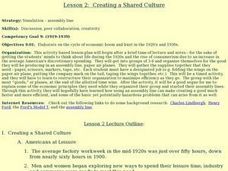Curated OER
The Roaring 20s
America during the 1920s was quite an interesting place! Bring the jazz, poverty, consumer excess, culture, and politics to life with this presentation. Primary source images, excellent descriptive text, and a wide span of topics are...
Curated OER
Ford's Revolution
Industrialization and mechanization of products such as cars have deeply affected the US economy. The class discusses the affects of Ford's assembly line production of automobiles. They watch a video, fill out worksheets, and investigate...
Curated OER
Paper Production
Students compare paper making by hand and by assembly line. In this manufacturing lesson, students compare and contrast the two main ways to make paper, by hand or by machine. Students research paper making and have a class discussion...
Curated OER
Creating a Shared Culture
Students simulate working on an assembly line in a shared culture. In this consumerism lesson, students participate in a lecture and note-taking session before working on a simulated assembly line. They work in a timed situation to...
Curated OER
Assembly Line and Henry Ford
Students examine how an assembly works. In this assembly line instructional activity, students discuss the details of an assembly line, then think of something in their home that they could put together in steps. Finally, they list the...
Curated OER
Interchangeable Parts Revolutionize Clock-making
Students consider assembly line production. For this lesson on Industrialization, students explore rifle manufacturing then create a workshop in the classroom to assemble clocks. They determine the pros and cons of assembly line...
Curated OER
Mass Production Using an Assembly Line
Fifth graders examine the industrial revolution. In this industrialization lesson, 5th graders explore the concept of mass production via the assembly line. They then create an assembly line which demonstrates its costs and benefits...
Curated OER
Henry Ford: A Cultural Icon
Students conduct research online for information about Henry Ford and his assembly line, examine economic, technological, and social changes that resulted from Ford's innovation, and use notes and resources to write five paragraph essays...
Curated OER
Quilting Bee-Assembly Line Style
Students identify the roles of a producer and a consumer. In this economics lesson, students define the roles of a consumer and producer and produce a quilt using an assembly line.
Curated OER
Assembly Line
Students explore the benefits of using the assembly line method of production rather than the conventional factory method. They create animals in the assembly line method. Students are assigned a certain task to do in order to complete...
Curated OER
The Assembly Line
Students create an assembly line and build a simple car from LEGO bricks. They explore about the effects of Ford's use of the assembly line, auto financing, and increased wages to make his fortune early in the 20th century.
Curated OER
Time, Talent, Treasure and Economics
Students work cooperatively to create a quilt. They choose a pattern and determine the specific skills and steps needed to produce that quilt. Labor is divided equally between group members and a quilt is created assembly line style....
Curated OER
Assembly Line Burgers
Students explore the reasons why the assembly line was formed and how it improves productivity. They practice with their own assembly line by making "burgers" out of wafers and frosting.
Curated OER
Writing Crazy Crayons
Second graders observe the workings of an assembly line. They classify old crayon pieces by color, melt them in candy molds, package them, and produce advertising literature to sell the product. Students share their work with the class.















